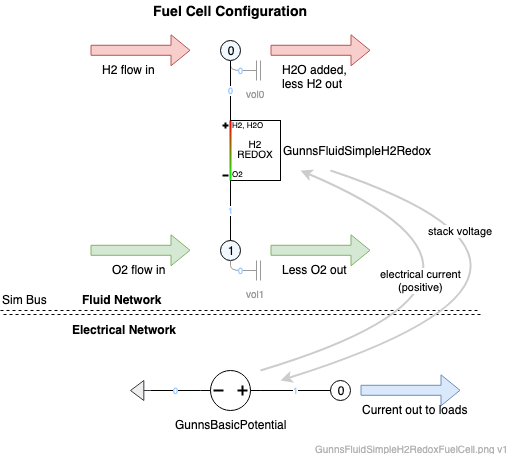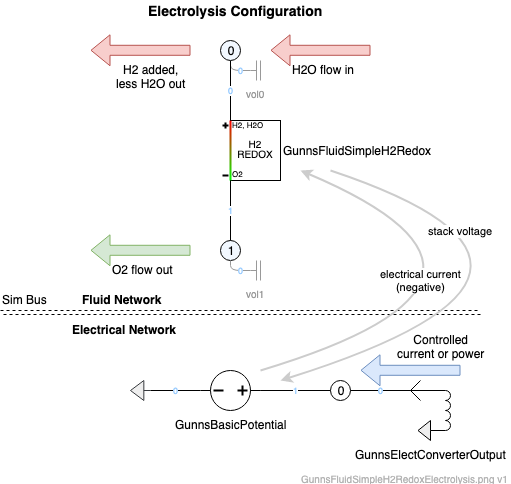GunnsFluidSimpleH2Redox - nasa/gunns GitHub Wiki

Background
This is a simple model of the fluid aspect of an H2 redox reaction device, such as used in H2/O2 fuel cells and water electrolysis. This pairs with a GunnsBasicPotential as the electrical aspect. This fluid link sends the voltage of the cell stack to the electrical aspect, and the electrical aspects returns a positive or negative current. Positive current is for a fuel cell, and negative current is for electrolysis. The electrical network controls the direction and amount of current. The fluid aspect either splits H2O into H2 and O2 (electrolysis), or combines H2 & O2 into H2O (fuel cell), in proportion to the current.
This link's blockage malfunction reduces the efficiency, which increases the fuel cell fluid reaction rate and reduces the electrolysis rate for a given current. The electrical aspect's blockage malfunction can be used to reduce the current and the reaction rate.
This link has many simplifications which may limit its usefulness:
- H2, O2 and H2O are in gaseous phase and are ideal gas. Only gas phase is supported and this can't support liquid water or H2 & O2 in solution with liquid H2O.
- Effects of temperature are not modeled.
- Energy is not conserved, because of the lack of reaction heat.
- Output voltage is not a function of temperature or load.
- Reaction efficiency is not a function of temperature, load, or fluid concentration.
- Absorption of contaminants and their effects on efficiency are not modeled.
- Inlet fluid concentrations have no effect, other than simply tripping off the reaction if inlet reactant pressures < 1 Pa.
How To Use in GunnsDraw
This is a 2 port fluid link. Port 0 attaches to the H2/H2O node, and Port 1 to the O2 node.
Port Connection Rules
These are limitations on the port connection to nodes that the link enforces in run-time:
- Both ports can only connect to gas phase nodes.
- Neither port can connect to the network Ground node.
Fuel Cell Configuration
Pictured below is the aspect diagram for this link and its electrical aspect running as a fuel cell. The fluid network must flow enough H2 & O2 to the nodes to maintain at least 1 Pa of those gas types in the nodes or the reaction trips off and outputs zero voltage. H2 & O2 are removed, and H2O added in proportion to the current. The electrical aspect feeds downstream loads, and the resulting current drives the fluid reaction rate.

Electrolysis Configuration
Electrolysis is basically the reverse of the fuel cell flow directions, but the connections between the aspects are similar, as shown below. A constant-current or constant-power source (GunnsElectConverterOutput) controls the current through the electrical aspect, which drives the electrolysis reaction in the fluid aspect. The fluid network must flow enough H2O to the node to maintain at least 1 Pa of H2O pressure or the reaction trips off.

Configuration Data Parameters:
- numCells (default = 0, must > 0): this is the number of cells in the device stack. The output voltage and reaction rates stack proportionally to the number of cells.
- cellVoltageLoaded (default = 0 (V), must > 0): this is the nominal voltage of each cell when the reaction is not tripped off. The total output voltage of the fluid link will be this number times numCells.
- cellH2ReactRate (default = 0 (kg/s/amp), must > 0): this is the rate of H2 mass that is reacted per amp of current, per cell. The total H2 reaction rate is this value times numCells, divided by effective efficiency. O2 and H2O rates are proportional to this by the reaction stoichiometry.
- maxEfficiency (default = 0, must < 0 and <= 1): this is the maximum reaction efficiency. The effective efficiency is reduced from this value towards zero as the blockage malfunction increases.
Input Data Parameters:
- current (default = 0 (amp)): this is the initial electrical current given to the fluid aspect.
- trippedOff (default = false): this is the initial tripped off flag. Initializing this to true disables the reaction and voltage output.
Common Problems:
- N/A
References:
- "The HESTIA Project: Solid Oxide Fuel Cell Model Validation", Jason Harvey, July 31, 2016.